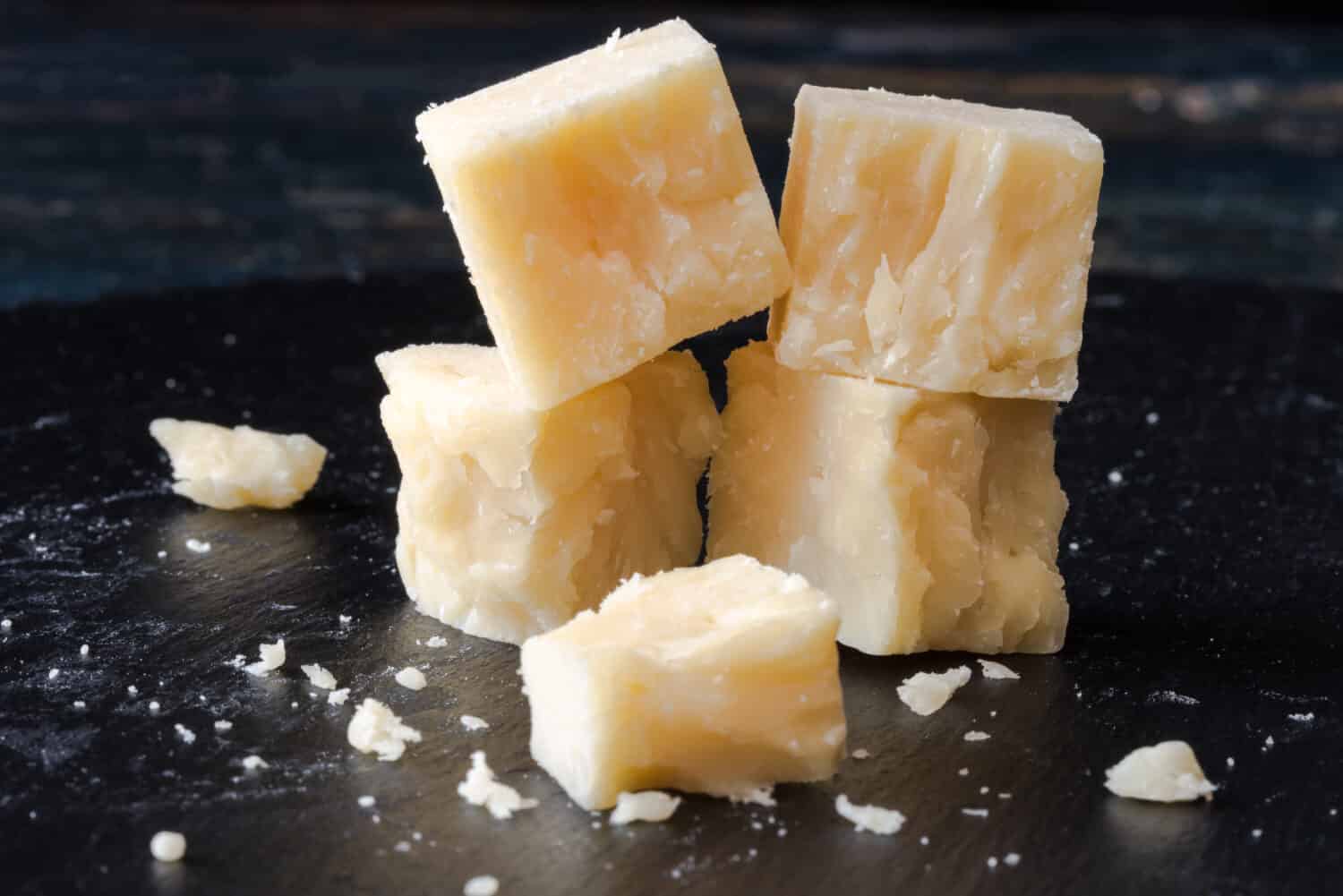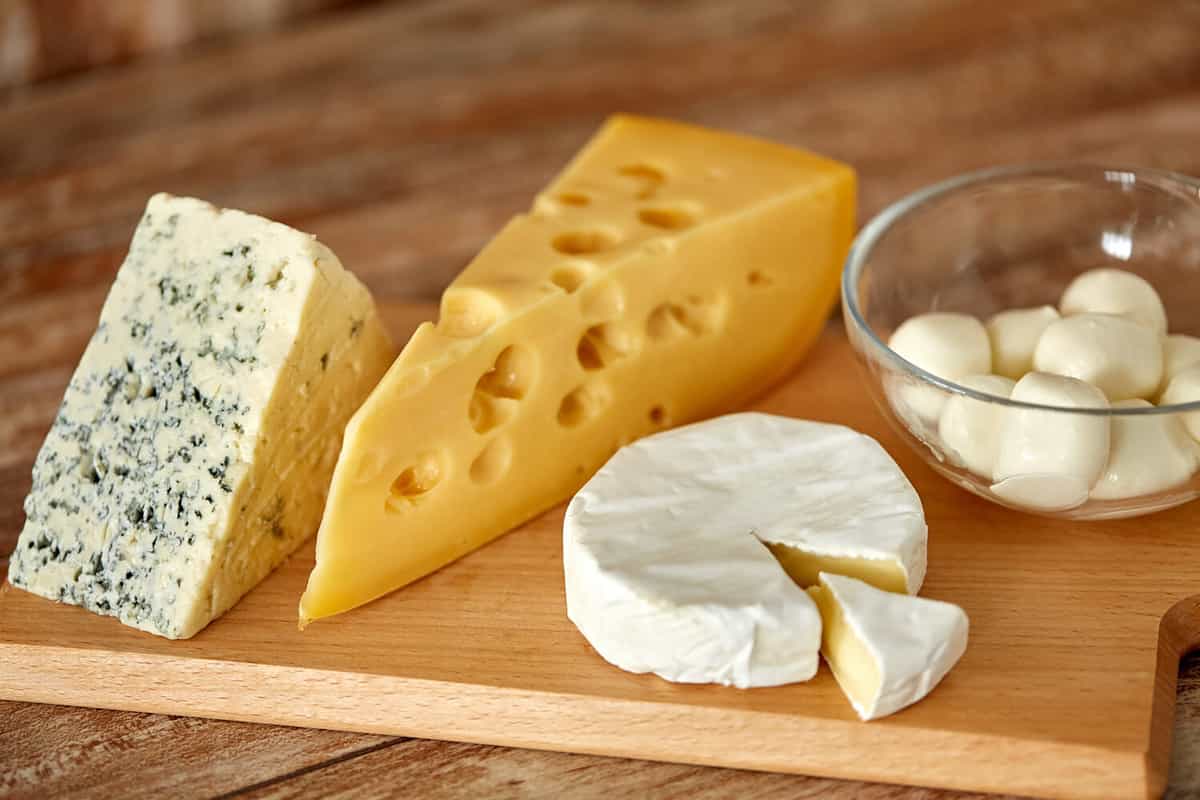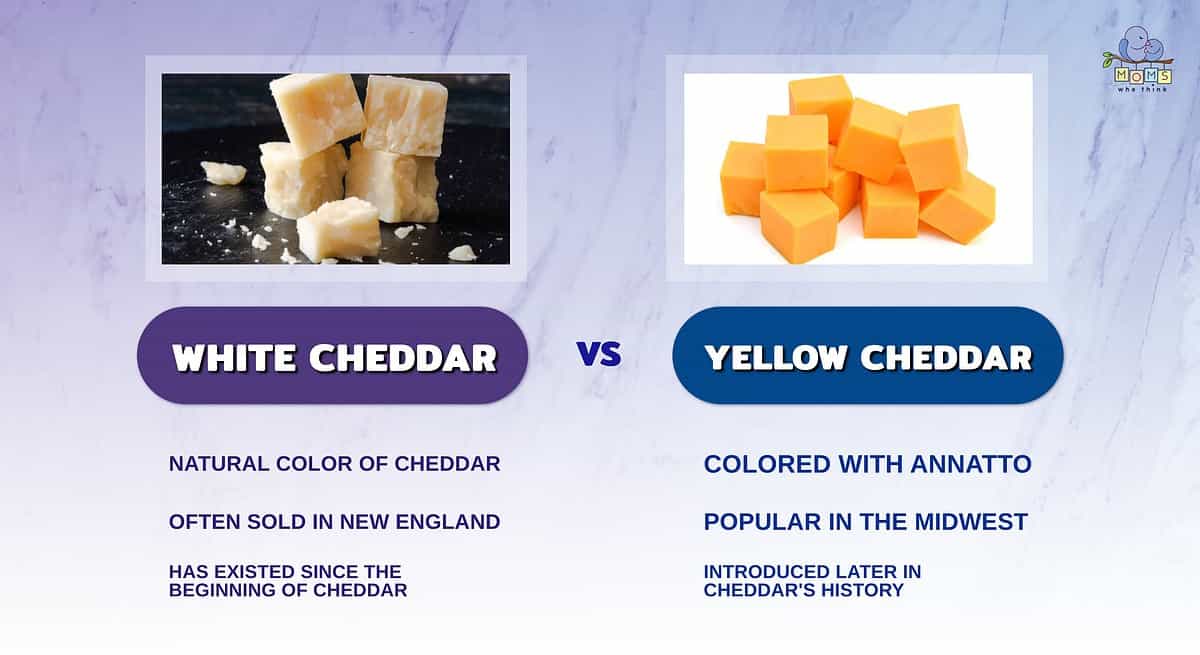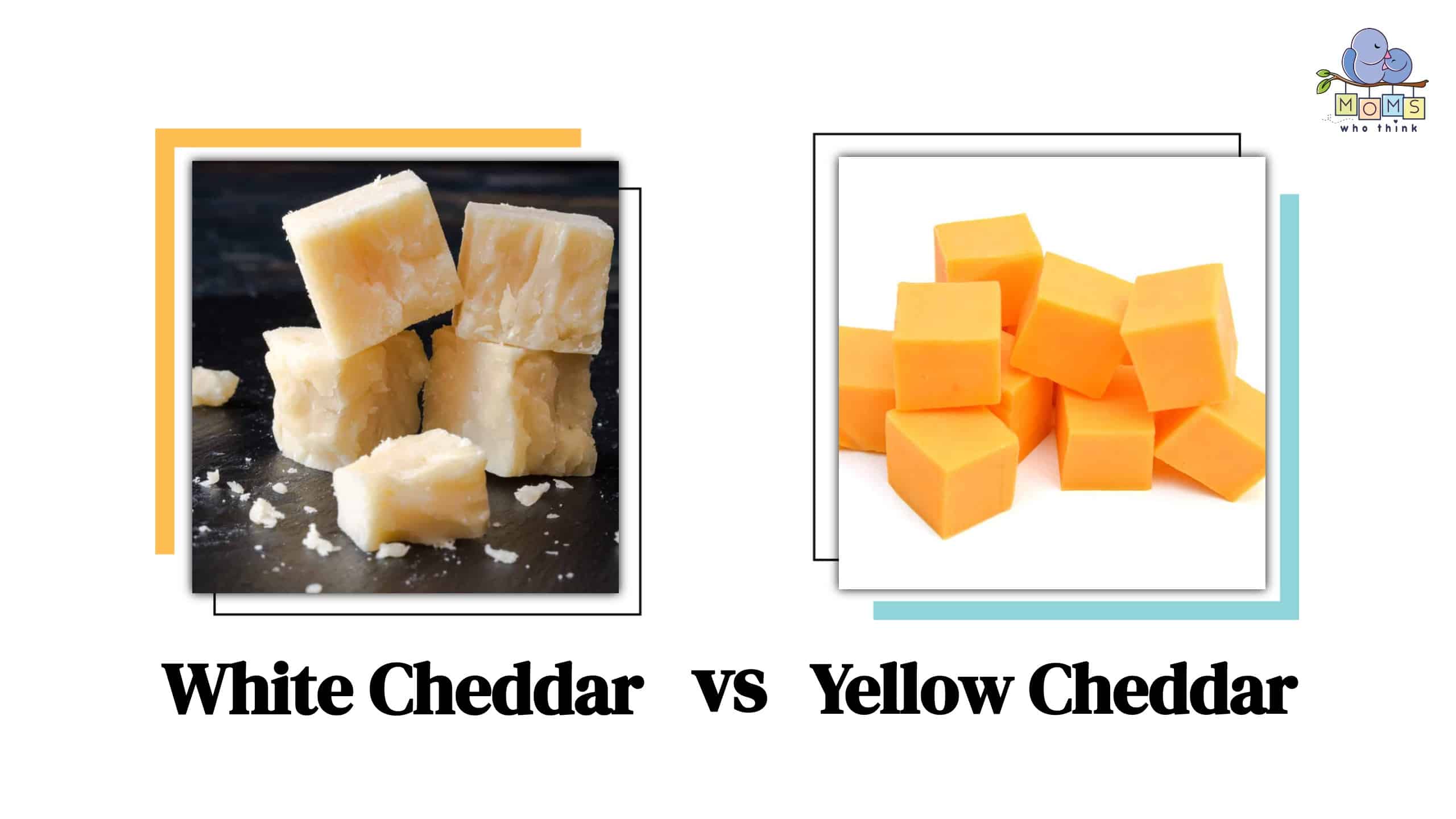When you think of cheddar, you more than likely think of the yellow-orange variety found in your local grocery store. But did you know that there is a natural white version of cheddar cheese that is just as equally delicious and versatile?
In this post, we'll dive into the specifics of cheddar, both white and yellow, including what sets them apart. Whether you're looking for the perfect addition to snack time, your kiddo's lunchbox, or a family meal, this post will provide a comprehensive guide to cheddar and all that this delicious and popular cheese has to offer.
White Cheddar vs. Yellow Cheddar: What is the Difference?
The only difference that truly separates white cheddar vs. yellow cheddar is the coloring. White cheddar is simply cheddar cheese in its natural state with an off-white or buttery coloring while yellow cheddar has a golden color due to the addition of annatto, a natural food dye that comes from the seeds of the achiote tree.
According to this article from the Auguste Escoffier School of Culinary Arts, cheddar made in the New England area of the United States is often kept white in color. Yellow cheddar, on the other hand, is more popularly produced and sold in the Midwest. Depending on where you live, you may be more familiar with one or the other. But what separates them remains the same: Only the color.
What is Cheddar?

©Michelle Lee Photography/Shutterstock.com
Whether you're using white or yellow, cheddar is a semi-hard cheese that's made from cow's milk. It originates from England, has a slightly crumbly texture, and can have a sharp flavor depending on how long it has been left to age.
Origin
Cheddar cheese originates from the town of Cheddar in Somerset, England dating back as far as the 12th century. It's thought that the original production of cheddar was white, with the yellow coloring being a later addition to the production process.
As the production process was enhanced over time, techniques were developed for controlling the temperature and acidity of the milk to produce consistent and high-quality cheese. Soon after, cheddar cheese was exported to other countries.
Cheddar cheese is now one of the most popular cheeses across the world. Large cheese factories have been created to meet the growing demand and numerous varieties of this sharp, tangy cheese.
Flavor
Despite their different coloring, white and yellow cheddar do not taste any different from each other. Both colors of cheddar have a distinct, tangy flavor that becomes sharper and more complex as it ages. Fresher forms of cheddar cheese are milder, with a slight buttery flavor while aged versions become more distinct in flavoring.
Texture and Appearance
Cheddar, in general, is a somewhat crumbly cheese and has a much drier consistency due to its aging and manufacturing process. As mentioned, white cheddar is the coloring of the cheese in its natural state. Yellow cheddar is the by-product of the addition of annatto to the cheese. This is sometimes done to control the coloring of the cheese and give it a more uniform yellow-orange pigment.
How Cheddar Cheese Is Made
Cheddar cheese, whether white or yellow, begins its production process like most cheeses: By adding rennet to milk in order to create curdles. The curds are then cut into pieces, pressed, and continually flipped to remove as much liquid (or whey) as possible. What's left is dense, dry, and somewhat crumbly cheddar cheese. This process of stacking and turning the curds repeatedly is unique enough that it's been coined, “cheddaring.”
Cheddar also has a longer aging period than most cheeses. Mild and young varieties of cheddar are aged two to three months. Extra sharp versions are left to age for at least a year and sometimes longer.
For white cheddar, the cheese is left to age naturally. As mentioned, yellow cheddar has a small amount of annatto added to it to create the rich yellow-orange color we see today.
Popular Uses
Both white and yellow cheddar are extremely versatile. While either color of cheese can be used on sandwiches, burgers, macaroni and cheese, and soups, they're also popular for snacking and pair well with fruits, nuts, and crackers.
It's also important to note that the pre-shredded forms of cheddar cheese typically found in your local grocery store include cornstarch to prevent clumping. If you're looking for a stronger flavor and a more creamy melted version, try shredding a block of cheddar yourself. Both white and yellow cheddar are easy to shred and offer a creamier texture when shredded fresh.
Common Misconceptions
Because of the difference in color between white and yellow cheddar, many assume these cheeses will taste different from each other. While annatto is added to yellow cheddar to give it its coloring, it doesn't affect the overall flavor. White and yellow cheddar, aged the same, should taste identical.
Speaking of aging, the biggest difference in flavors of cheddar (whether white or yellow) is the aging process. As mentioned, aged cheddar tends to be drier and has more of a sharpness to it, while young cheddar is milder and not as crumbly. Both aged yellow cheddar and aged white cheddar should taste the same if they have the same aging time.
Best Substitutes for White or Yellow Cheddar

©Ground Picture/Shutterstock.com
Because both white and yellow cheddar have the same texture and flavor, they can easily be interchangeable in recipes and snacks. The only difference in your recipe will again be the color. Both white and yellow cheddar offer the same melty goodness when heated, and can be eaten plain and paired with snacks.
If you find yourself in a pinch or want to experiment with different textures and coloring that are similar to cheddar, try the following substitutes:
Monterey Jack
Monterey Jack tends to be a bit softer, than cheddar as it's a semi-soft cheese. But its mild flavor and creamy texture make it a solid replacement for young cheddar.
Gouda
Aged gouda is an excellent substitute for the aged sharpness of cheddar cheese. Gouda also has a similar firm texture to cheddar.
Colby
Colby and yellow cheddar are often confused with each other due to their similar yellow-orange coloring. While Colby tends to be a bit moister than cheddar, it can still work as an appropriate substitute.
Colby Jack
This cheese is a blend of Colby and Monterey Jack cheeses, making it a bit softer and creamier than cheddar, but still an excellent replacement if needed.
Muenster
Muenster cheese tends to have a creamy and slightly soft texture, but its creaminess and mild flavor closely resemble that of young cheddar.
White Or Yellow Cheddar Recipes
Either white or yellow cheddar is sure to up-level the following recipes:
Print
Cheddar Barbecue Chicken Breasts
Ingredients
4 boneless skinless chicken breasts
8 strips bacon, cooked
Shredded cheddar cheese
1 bottle barbecue sauce
Instructions
1. Cover Chicken breasts with barbecue sauce and bake until done, about 15-30 minutes in a 350 degree oven.
2. Remove from oven, pour additional barbecue sauce on top, place bacon strips on top of the chicken breasts and cover with cheddar cheese.
3. Return to oven until cheese melts. Serves 4.
- Garlic Butter Cheddar Chicken
- Cheddar Baked Cauliflower
- Cheddar Burger Mashed Potato Bake
- Brown Sugar Glazed Cheddar Meatloaf
Final Thoughts

- Many people may not know that cheddar is actually naturally white. The yellow color of some cheddar comes from annatto. If artificial dyes are a concern to you, no worries- annatto is natural.
- White cheddar is commonly sold in New England, while yellow cheddar is popular in the Midwest. You can likely find both kinds of cheddar across the U.S., though.
- White cheddar is believed to have been the first type of cheddar; yellow cheddar was introduced later on.
In conclusion, both white and yellow cheddar are delicious and versatile forms of cheddar cheese. Whether you're a fan of the traditional yellow cheddar or prefer the more natural white cheddar, both types of cheese are made using the same production process. The only difference between the two is the addition of annatto to yellow cheddar, giving it its distinctive hue.
Regardless of your preference, cheddar cheese is a great addition to any snack, lunch, or family meal, and is sure to bring a flavorful bonus to your next recipe.


